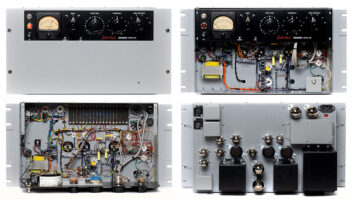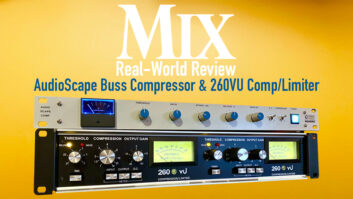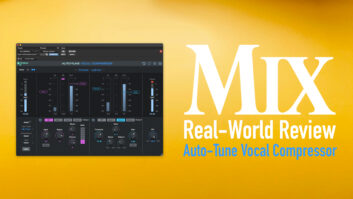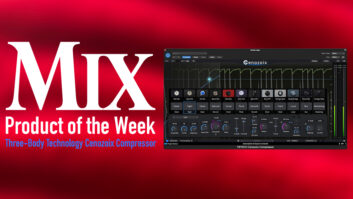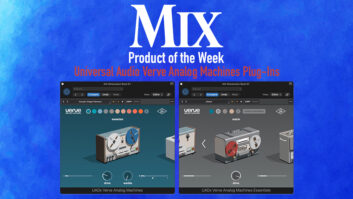
Most engineers of a certain age can name a favorite piece of outboard gear from the “good old days,” and one perennial favorite is the Universal Audio 1176 Peak Limiter. Starting in 1967, about 12,000 to 15,000 1176s were manufactured (the initial retail price was $489), but more than 30 years later, the number of good examples still in fine working condition has shrunk to the point that there is now a market for a replica product.
The original 1176 design went through many revisions (see sidebar for an exhaustive survey), but most connoisseurs of vintage gear agree that the “black-face” D and E versions sound the best. The new Universal Audio 1176LN reissue is based on the D and E revisions and comes as close as you can get to “the sound of ’67” without a time machine. MSRP is $2,295.
USING THE 1176
The newly reissued 1176 operates in exactly the same way as a good, working vintage 1176. The only visible changes are the new XLR input and output connectors in parallel with the original terminal strip connections. I have always liked the 1176’s simple operation; there are just four preset compression ratios: 4:1, 8:1, 12:1 and 20:1. Attack time is adjustable from 20 to 800 microseconds, and release time goes from 50 milliseconds to 1.1 seconds. (Remember, attack and release were nonadjustable in compressors such as the Universal Audio LA-2 Leveling Amp; control over these parameters was a relatively new concept in 1967.)
Go to the Focus on Universal Audio page to see video and learn more about UA products.
Once you have decided on ratio, attack and release settings, you just crank up the large Input knob and set the amount of gain reduction-the threshold control is internally set for least distortion. The single large, lighted VU meter measures either RMS gain reduction or output level and offers a choice of either +4dBm or +8dBm calibration. After arriving at the required amount of gain reduction, it may be necessary to readjust attack and release times.
The Output knob adjusts make-up gain and, hence, the final output level. However, cranking up the Input knob also affects post-compression output levels, so setting the 1176 is a two-fisted operation: Wind up the Input with your left hand to increase compression and adjust the Output with your right hand.
Instead of a regular bypass switch, the 1176LN has an Off switch engaged by turning the Attack knob fully counterclockwise. In this mode, the unit becomes a straight-ahead line amplifier; some engineers like to run signal through the 1176 in the Off mode just for the sound.
OLD VS. NEW
I was able to compare the sound of a single new 1176LN reissue with four different vintage black-face 1176LNs, two D and two F revs, all in pristine condition and sounding as good as any 1176s I have ever heard.
It is important to note that all vintage 1176s sound slightly different from each other, even ones with sequential serial numbers. This is generally because many units are now out of calibration and produce higher levels of distortion than normal (a good thing for some applications). Aging capacitors and/or other problems may also contribute some differences in sound. Since the 1176 uses a mic-level input transformer and a FET for gain reduction followed by a mic preamp, it always has a “hot” sound. No matter what sound you put into it, you are going to get an edgier and more aggressive sound out of it. This makes sense to me-look at the 0.5% THD specification with 45 dB of gain. You don’t usually see those kinds of numbers on modern VCA compressors.
For my test, I used recorded sound sources from an all-analog recording session. After calibrating all five 1176s with a 1kHz tone and setting the same amount of compression on each unit, I tried different amounts of squash to find a starting point. For critical sonic comparisons, I eventually chose a ratio of 4:1, medium attack and release times and just -3 dB of gain reduction (set with a steady tone). On all four vintage compressors, I wound up using the same numerical setting on the Input knob to achieve the same amount of compression. This indicates that the Q-Bias and compression threshold pots on all units were all well-calibrated.
For the listening test, I used recordings of a single lead vocal, a bass guitar track, a snare drum track as well as the entire live kit and a single grand piano track. The revision F models, with their AB output amps, had a lot more output level and a “hotter” sound than the rev D models; to match loudness I had to crank up the Output control on both the 1176LN reissue and the rev Ds.
As expected, the rev Ds sounded the closest to the 1176LN reissue, with one of the old Ds sounding extremely close. Because it was cleaner than the vintage units, I liked the sound of the new unit better for bass or low frequencies. Vocals sounded pretty much the same between the two Ds and the reissue, but also sounded very good through the Fs. Drum kits and individual drums were smoother going through the 1176LN reissue. The piano makes an excellent test of harmonic distortion characteristics, and the reissue won-it was the cleanest. Maybe it’s just the brand-new components instead of old leaky capacitors in the 30-year-old units, but in general all sounds were clearer and less grindy through the 1176LN reissue.
However, according to Bill Putnam Jr., the 1176LN reissue has slightly less gain and the taper of the Output pot is different, and I had to turn up the Output knob more to match loudness of the older units. And, yes, you can still push all the ratio buttons in at once on the reissue-just pushing in the 20:1 and 4:1 buttons together has the same effect.
Two 1176LNs can be stereo coupled by using the 1176SA or Stereo Interconnect Accessory. The stereo-coupled setup needs to be calibrated, and the attack and release controls on each unit interact; changing the controls on either unit will affect both units. In stereo coupling mode, the attack time is doubled, so the fastest attack time in stereo is 40 microseconds.
Universal Audio, Box 3818, Santa Cruz, CA 95063; 831/454-0630; www.uaudio.com.

